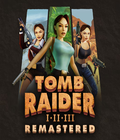The original Tomb Raider came out in 1996 on the Sega Saturn, Sony PlayStation, and PC. The initial announcement was followed by a ton of hype to the point where the heroine Lara Croft became a recognizable game icon even before the game was released. The game lived up to the hype, and its massive success spawned a series that is still kicking. Last year, Nintendo broke the news that the first three games in the series would be remastered, and we finally have Tomb Raider I-III Remastered in our hands. While three bona fide classics from the early 3D era in one package would normally be cause for celebration, the result isn't so cut-and-dry.
For those unfamiliar with the series, the storyline for all three games can be summed up as "Indiana Jones" for the late 1990s with guns. You play as Lara Croft, an adventurer and archaeologist renowned for her ability to go through ancient ruins and find treasure. Every game sets you on a quest to find an important ancient relic, and it's peppered with brief alliances and betrayals — and the revelation that each of the artifacts can lead to immense power and/or the destruction of the world. They're simple stories, and even though the story blueprints are similar, they're still exciting .
There are a few key gameplay pillars that all three games rely on. The platforming is one of the pillars, and the moves seem rudimentary nowadays, but it was revolutionary when the first title launched. It felt nimble to be able to somersault, grab ledges, shimmy, and do quick 180-degree turns. Along with the platforming, the puzzles and traps feel familiar because this is one of the games that inspired puzzle-solving in modern action titles. Most of the puzzles involve locating switches or artifacts and keys to open doors, but the pathways and different environments keep things interesting.
Combat is the game's other big pillar, but it is also considered to be the weakest part of the series in these early entries. The game tries to make gunplay seem exciting, as your default double pistols get infinite ammo without reloading. You get more powerful guns later — including Uzis, shotguns, and a harpoon — but they have limited ammo, forcing you to be judicious about their usage. Aiming is automatic, and it works in a pinch, but it feels like you aren't shooting correctly. Most attacks boil down to holding down the shoot button, moving around, and hoping for the best. Compared to the well thought-out platforming and puzzle-solving, the combat needs some polish, but the series doesn't achieve that until Tomb Raider: Legend.
From a gameplay perspective, two big improvements are being touted in this remastering effort. The first is the availability of the expansion packs for all three games. The expansion packs were available in downloadable form and as part of some of the budget releases, but they were never part of the Steam or GOG releases, so having these official levels built into each of the games is a very welcome addition for fans.
The second improvement, and perhaps the biggest one for many people, is the modernized control scheme. The original tank-style controls are still available, but the modern scheme is more akin to a modern action game. On a controller, that means the jump button is A. Pulling the left trigger pulls out your guns, and the right trigger fires. The right analog stick controls a free-moving camera. It's intuitive enough that anyone who has ever played a third-person action game can immediately play this, but the option remains to remap every button for more control granularity.
Unfortunately, the new control scheme introduces a litany of problems. Some of the moves are missing, like the basic walk. Even with analog stick controls, you're either standing still or running. You also have two action buttons instead of one, so you'll use one to flip switches and pick up items and another to get out of the water. The biggest issue is that the game was never tweaked to handle the new control scheme. This is evident whenever you go to Lara's manor. In the first game, the tutorial only references the tank controls, so you'll never know how to get out of the pool. In the second game, this means that you'll never complete the obstacle course without a ton of compensation, since you're leaping further and missing the mark. It becomes problematic when you're in tight spaces because the camera tends to freak out. Sometimes it'll lead to situations where you can't see where to go because the camera doesn't pull back to show you the floors and gaps. Other times, the game decides to emulate the original Resident Evil and have your controls be interpreted as movements somewhere else. It makes the game almost unplayable at times, since the camera can be disorienting. You can change some options to fix this, but the solution is far from ideal when the original game handled well.
The game touts an improved control scheme for the modern era, and that's about it for improvements to the game mechanics. The aforementioned lack of a map or waypoints is fine, but adherence to other old mechanics is more annoying. For example, there aren't any graphics options. The game doesn't require much to run well, but seeing the resolution you're running it on and being able to tweak settings is an expectation in modern PC gaming. The game also doesn't autosave, so you need to manually save to avoid losing progress due to an untimely trap or fall. Manually saving might have been commonplace when the game was initially released, but it's a strange concept now.
If you're expecting fanfare for the package, prepare to be disappointed. There's the title screen for each game, complete with the rotating selection menus and artwork for each title. Going up and down the list changes the menu between one of the three games, and that's pretty much it. The extras menu gets you the EULA and credits, but that's it.
Tomb Raider I-III Remastered celebrates the first three titles in the series, but it omits the last two titles created for the original PlayStation era. The Last Revelation was the fourth game in the series, and it left Lara's fate a mystery. Tomb Raider Chronicles was more of a compilation of lost adventures, as it told the tale in episodic flashback form instead of making one cohesive narrative like past games. These aren't very popular games in the series, especially when compared to the first three titles. However, they are still significant entries since they mark the last two titles of the original PlayStation era, so it is a shame that they didn't receive the same treatment.
Graphically, the games sit in an interesting place. Lara looks good, and although it isn't the kind of upgrade that was seen in Tomb Raider: Anniversary, it works as a more cleaned-up version of the original model. The environmental textures are cleaner, and foliage has been spruced up to look fuller. The tomb environments feature the addition of more light shafts and unreachable openings. However, the remastered results aren't as much of an upgrade as hoped. The full-motion video cut scenes are upscaled versions of the originals, so you're still going to see the old models with janky movement and facial expressions and with more blur. Many parts of the environment still sport an angular look with sharp edges. Bodies of water look worse than the original, since you can't easily discern the texture until you see it undulate. There are rarely instances of failed collision, but clipping is rampant enough that you feel like you'll go through a wall at any moment. The game has a brighter appearance that makes some places easier to see but robs the game of some ambiance in the process.
Tapping a button instantly swaps out the more updated graphics for the original look, and the difference is stark. It does a good job of showing off some of the improvements, and it also highlights how well done some of the old textures and lighting were compared to the modern version. What is perhaps more surprising is how reverting to the old look also changes the mechanics and performance. The frame rate drops significantly from 60fps to 30fps and with enough microstutters that the effect looks bad. Full camera movement is removed, so you won't see the camera shake violently while near a wall, but it also mean that the modern controls don't work as well with the old visuals. The awkward thing is that the button to revert to the original graphics is traditionally used to pause the game. If you want to pause the game or access your inventory, you'll end up accidentally switching between graphical styles.
Compared to the graphics, the audio hasn't received much of a touch-up. In some cases, that's good since the CD audio comes through nicely for the moments when music is needed. The vocal tracks are still the same, which means it can come in clearly in some cases and play with a bit of background noise in others. The sound effects also demonstrate some variation in terms of quality, but overall, the sounds are good enough to not garner many complaints.
The collection makes a fantastic showing on the Steam Deck. Each game shows up using the full 1280x800 resolution of the device, and while the full-motion video cut scenes lock themselves to 30fps, the main game hits a steady 60fps with no drops. It takes little horsepower to run the title, so the Steam Deck on a full battery charge can run the game for over six-and-a-half hours, and you can even push it to seven hours if you want to run the game on original graphics. In short, there's nothing to complain about if you're a Steam Deck user.
It's difficult to give a score to Tomb Raider I-III Remastered. On the one hand, some of the improvements are quite good. The inclusion of extra levels for each game to make them more accessible is always welcome, and the improved modern controls are certainly welcome unless your muscle memory is attuned to the old tank-style controls. On the other hand, the very slight graphical improvements are overshadowed by the fact that the game design fails to keep modern controls in mind, and no other changes have been made to bring it up to modern standards. Considering the pedigree of the games, the result is a package that's fine but could've been much, much better.
Score: 5.0/10
More articles about Tomb Raider I-III Remastered Starring Lara Croft











 Tomb Raider I-III Remastered Starring Lara Croft bundles the first three Tomb Raider titles, lovingly restored with upgraded graphics and performance enhancements, complete with all expansions and secret levels.
Tomb Raider I-III Remastered Starring Lara Croft bundles the first three Tomb Raider titles, lovingly restored with upgraded graphics and performance enhancements, complete with all expansions and secret levels.



















